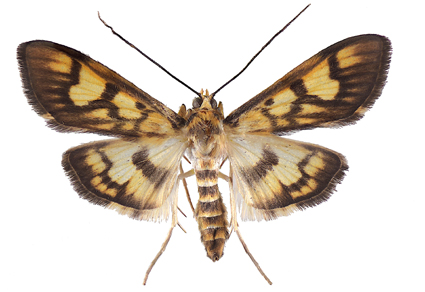Abstract
An unidentified spilomeline moth, “Nosophora sp.” was first illustrated by Inoue (1982) from Japan. Since little is known about the immature stage of “Nosophora sp.”, we attempted to rear this species from eggs. As a result, we found that “Nosophora sp.” can be successfully reared on Quercus serrata Murray and Q. glauca Thunb. Surprisingly, of the adults that emerged, all females showed the “Nosophora sp.” phenotypes, while all males showed the N. insignis (Butler, 1881) phenotypes. We also found that the mitochondrial COI sequences of “Nosophora sp.” and N. insignis are completely identical. Based on these results, we concluded that “Nosophora sp.” and N. insignis represent the sexual dimorphisms of the same species, and redescribed N. insignis.
References
- Butler, A.G. (1881) Descriptions of new Genera and Species of Heterocerous Lepidoptera from Japan. Pyrales and Micros. Transactions of the Entomological Society of London, 1881, 579–600. https://doi.org/10.1111/j.1365-2311.1881.tb00882.x
- Choi, S.W., Kim, S.S. & Jeon, J.A. (2020) Four new records of Crambidae (Lepidoptera) from Korea. Journal of Asia-Pacific Biodiversity, 13, 401–405. https://doi.org/10.1016/j.japb.2020.03.014
- Hampson, G.F. (1896) Moths. Vol. IV. The Fauna of British India, including Ceylon and Burma, London, 4, 1–594. https://doi.org/10.5962/bhl.title.48423
- Hampson, G.F. (1918) Descriptions of new Pyralidae of the subfamily Pyraustinae. Annals and Magazine of Natural History, including Zoology, Botany and Geology, Series 9, 1, 252–262. https://doi.org/10.1080/00222931808562310
- Heo, U.H. (2016) Guide book of moth larvae 2. Econature, Seoul, 392 pp.
- Inoue, H. (1982) Pyralidae. In: Inoue, H., Sugi, S., Kuroko, H., Moriuti, S. & Kawabe, A. (Eds.), Moths of Japan. Vol. 1 & 2. Kodansha, Tokyo, pp. 307–404 & pp. 36–48 + 223–254 + 296–314.
- Kaaber, S., Kristensen, N.P. & Simonsen, T.J. (2009) Sexual dimorphism and geographical male polymorphism in the ghost moth Hepialus humuli (Lepidoptera: Hepialidae): Scale ultrastructure and evolutionary aspects. European Journal of Entomology, 106, 303–313. https://doi.org/10.14411/eje.2009.036
- Lederer, J. (1863) Beitrag zur Kenntniss der Pyralidinen. Wiener Entomologische Monatschrift, 7 (8, 10–12), 243–280, 331–504, pls. 2–18.
- Mallet, J. (1984) Sex roles in the ghost moth Hepialus humuli (L.) and a review of mating in the Hepialidae (Lepidoptera). Zoological Journal of the Linnean Society, 80, 67–82. https://doi.org/10.1111/j.1096-3642.1984.tb02320.x
- Mally, R., Hayden, J.E., Neinhuis, C., Jordal, B.H. & Nuss, M. (2019) The phylogenetic systematics of Spilomelinae and Pyraustinae (Lepidoptera: Pyraloidea: Crambidae) inferred from DNA and morphology. Arthropod systematics and Phylogeny, 77, 141–204. https://doi.org/10.26049/ASP77-1-2019-07
- Matsui, Y. & Naka, H. (2018) Early stages and host plant of crambid moth Syllepte segnalis (Leech) under rearing conditions. Japan Heterocerists’ Journal, 286, 265–267. [in Japanese with English summary]
- Matsui, Y., Naka, H. & Jinbo, U. (2021) DNA barcoding and morphology reveal a new cryptic species of Nagiella (Lepidoptera, Crambidae, Spilomelinae) from Japan. Zookeys, 1023, 171–192. https://doi.org/10.3897/zookeys.1023.60934
- Matsui, Y., Mally, R., Kohama, S., Aoki, I., Azuma, M. & Naka, H. (2022) Molecular phylogenetics and tribal classification of Japanese Pyraustinae and Spilomelinae (Lepidoptera: Crambidae). Insect Systematics & Evolution, 54 (1), 77–106. https://doi.org/10.1163/1876312X-bja10037
- Nuss, M., Landry, B., Vegliante, F., Tränkner, A., Mally, R., Hayden, J., Segerer, A., Li, H., Schouten, R., Solis, M.A., Trofimova, T., De prins, J. & Speidel, W. (2003–2024) Global Information System on Pyraloidea. Available from: http://www.pyraloidea.org/ (accessed 4 March 2024)
- Robinson, G.S., Ackery, P.R., Kitching, I.J., Beccaloni, G.W. & Hernández, L.M. (2010) HOSTS—A database of the world’s lepidopteran hostplants. Natural History Museum, London. Available from: http://www.nhm.ac.uk/hosts (accessed 25 October 2022)
- Sasaki, A. & Yamanaka, H. (2013) Spilomelini. In: Nasu, Y., Hirowatari, T. & Kishida, Y. (Eds.), The Standard of Moths in Japan IV. Gakken Education Publishing, Tokyo, pp. 74–84 + 433–478.
- Slamka, F. (2013) Pyraloidea of Europe: Identification, Distribution, Habitat, Biology. Pyraustinae & Spilomelinae. Vol. 3. František Slamka, Bratislava, 357 pp.
- Solis, M.A., Phillips-Rodríguez, E., Hallwachs, W., Dapkey, T. & Janzen, D.H. (2020) Asturodes Amsel (Lepidoptera: Crambidae: Spilomelinae): Three New Species from the Western Hemisphere and Food Plant Records from Area de ConservaciÓn Guanacaste, Costa Rica. Proceedings of the Entomological Society of Washington, 122, 147–171. https://doi.org/10.4289/0013-8797.122.1.147
- Walbauer, G.P. & Sternburg, J.G. (1975) Saturniid moths as mimics: an alternative interpretation of attempts to demonstrate mimetic advantage in nature. Evolution, 29, 650–658. https://doi.org/10.2307/2407075
- Yazaki, H. & Hayashi, F. (2023) Possible Batesian mimicry to sexually different models in the tussock moth Numenes albofascia with a great sexual color dimorphism. Entomological Science, 26, e12557. https://doi.org/10.1111/ens.12557


